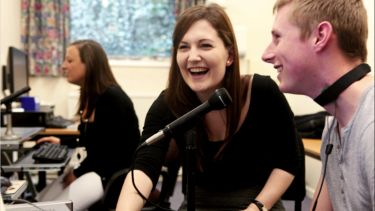HumLab
The HumLab acts as catalyst for interdisciplinary research on language, music and cognition, and houses specialist equipment and facilities.

Booking
If you would like to book the HumLab, please complete this Google Form. This is open to internal (University of Sheffield) and external users. Please contact artsresearchhub@sheffield.ac.uk if you have any queries about this facility.
Research strands
Our interdisciplinary research investigates the complexity and creative expression of the human mind. Sheffield is strongly committed to interdisciplinary work, and the HumLab promotes multidisciplinary and interdisciplinary research centred on areas that are core to the Arts and Humanities.
Supporting Arts and Humanities research
The HumLab makes it possible for colleagues from English, Languages & Cultures, Music and Philosophy, who share theoretical and methodological interests and concerns, to join up their research and let their disciplines thrive on cross-fertilisation. We use the laboratory-based methods employed in the study of language and music, and apply them to other disciplines, such as literature, film studies and the visual arts.
Supporting cognition research
Cognition research helps shape our understanding of music and language and vice versa. By pursuing joint research hypotheses from different angles, it enables us to go beyond incremental progress within a discipline.
The type of empirical and quantifiable data that the equipment housed in the HumLab makes available facilitates interdisciplinary communication and opens up avenues for collaboration with colleagues from across the university - most notably Cognitive Science, Neuroscience and Computer Science.
Facilities
Our lab is equipped with state-of-the-art technology allowing our researchers and students to push the boundaries of their disciplines.
Lab areas
The HumLab has three lab areas:
- Main lab with soft area and consenting space
- Sound booth and computer island
- Eye tracker room
Equipment
The HumLab contains the following equipment:
- Audio recording equipment
- Response pads (x5)
- Galvanic skin response system
- Eye-tracker*
- Electroglottograph
- Aerodynamic system
- Laptops (Lenovo Yoga) (x5), (MacBook Pro) (x1)
- Tablets (Lenovo 10) (x3), (iPad Air 2) (x1)
There are also 5 desktop computers available with the following software:
- MS Office
- Experimental software: EPrime, PsychoPy, OpenSesame
- Audio and video analysis software: Audacity, Praat, Adobe creative suite
- Statistical analysis software: R and RStudio, SPSS
People
HumLab staff have many different areas of expertise across several varying interests.
Languages
Music
Philosophy
English
*Please note that the use of the eye-tracking equipment in the HumLab requires specialist expertise and substantial training. At present we advise that students only use this equipment if they or their supervisors already have requisite knowledge. The sound booth and computers are suitable for general use.
